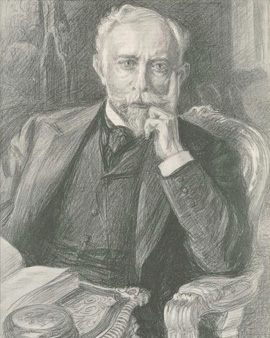A suspicious woman is brought before the London police court. The life of convicts at Wormwood Scrubs Prison. Dancing girls in the theatre, Irish children carrying peat for a small wage. Workers building the dome of the Grand Palace for the Paris World's Fair of 1900. The French officer Alfred Dreyfus before his judges, writer Émile Zola at his trial. The prominent composer Franz Liszt at the piano or the famous Madame Sarah Bernhardt in her dressing room. The French painter and illustrator Charles Paul Renouard has drawn countless of such often topical sceneries or portraits of well-known personalities. Scenes from the everyday life of ordinary people, from courtrooms and parliaments, from big events, from celebrations, parades and processions in European cities. The black-and-white pencil drawings were mostly published in the high-circulation newspapers and magazines of the time, such as the Paris Illustrated or the British weekly magazine The Graphic.
Paul Renouard lived and worked not only in Paris but often also in London. He also undertook numerous journeys through many European countries and visited the USA repeatedly. Coming from an extended family in a small village in the Loire Valley, Paul moved to Paris at the age of 14 to earn money - initially as a simple painter. Due to his talent for drawing, which he had already noticed in his childhood, he was accepted at the École d'Arts (School of Fine Arts) and subsequently became a valued student in the workshop of the painter Isidore Pils. Paul also helped him to complete the paintings on the vaulted ceilings of the staircase of the new Paris Opera House "Opéra Garnier", which opened in 1875.
The draughtsman Paul Renouard was actually almost a reporter, a journalist who was well informed about life in his environment and captured it in often quickly compiled but very precise and accurate pictures. Small series of portraits of politicians, for example, or captured scenes from the hustle and bustle of such institutions as the English clubs also show a good portion of the artist's humor. His works not only delighted the newspaper audience but also aroused admiration among fellow artists such as Vincent van Gogh. The competition from photography, which became increasingly fierce at the beginning of the 20th century, especially for those illustrators working for newspapers, could not stop Renouard from successfully publishing albums of etchings and lithographs (including the famous collection "Movements, Gestures and Expression" or the "War Album", which he created in the last years of his life). It is not for nothing that his works can still be found today, for example in the Louvre. The fact that Charles Paul Renouard, in view of his surname, was perhaps confused outside his home country with even more famous painters of his time is shown by the short note about his death in the "Salzburger Volksblatt" of 11 January 1924: There it was noted that "Viennese reports had mutilated his name as Renoir, the famous master from the fighting period of Impressionism".
×





.jpg)
.jpg)
.jpg)
.jpg)
.jpg)
.jpg)
.jpg)
.jpg)
.jpg)
.jpg)
.jpg)
.jpg)
.jpg)
.jpg)
.jpg)
.jpg)
.jpg)
.jpg)
 - (MeisterDrucke-193910).jpg)
 - (MeisterDrucke-193910).jpg)
.jpg)
.jpg)
.jpg)
.jpg)
.jpg)
.jpg)
.jpg)
.jpg)
.jpg)
.jpg)
.jpg)
.jpg)
.jpg)
.jpg)
.jpg)
.jpg)
.jpg)
.jpg)
.jpg)
.jpg)
.jpg)
.jpg)
.jpg)
.jpg)
.jpg)
.jpg)
.jpg)
.jpg)
.jpg)
.jpg)
.jpg)
.jpg)
.jpg)
.jpg)
.jpg)
.jpg)
.jpg)
.jpg)
.jpg)
.jpg)
_French_statesman_-_(MeisterDrucke-603567).jpg)
_French_statesman_-_(MeisterDrucke-603567).jpg)
.jpg)
.jpg)
.jpg)
.jpg)
.jpg)
.jpg)
.jpg)
.jpg)
.jpg)
.jpg)
.jpg)
.jpg)
.jpg)
.jpg)
.jpg)
.jpg)
.jpg)
.jpg)
.jpg)
.jpg)
.jpg)
.jpg)
.jpg)
.jpg)
.jpg)
.jpg)
.jpg)
.jpg)
.jpg)
.jpg)
.jpg)
.jpg)
.jpg)
.jpg)
.jpg)
.jpg)
.jpg)
.jpg)
.jpg)
.jpg)
.jpg)
.jpg)
.jpg)
.jpg)
.jpg)
.jpg)
.jpg)
.jpg)
.jpg)
.jpg)
.jpg)
.jpg)
.jpg)
.jpg)
.jpg)
.jpg)
.jpg)
.jpg)
.jpg)
.jpg)
.jpg)
.jpg)
.jpg)
.jpg)
.jpg)
.jpg)
.jpg)
.jpg)
.jpg)
.jpg)
.jpg)
.jpg)
.jpg)
.jpg)
.jpg)
.jpg)
.jpg)
.jpg)
.jpg)
.jpg)
.jpg)
.jpg)
 - (MeisterDrucke-194937).jpg)
 - (MeisterDrucke-194937).jpg)
.jpg)
.jpg)
.jpg)
.jpg)
.jpg)
.jpg)
.jpg)
.jpg)
.jpg)
.jpg)
.jpg)
.jpg)
.jpg)
.jpg)
.jpg)
.jpg)
.jpg)
.jpg)
.jpg)
.jpg)
.jpg)
.jpg)
.jpg)
.jpg)
.jpg)
.jpg)
.jpg)
.jpg)
.jpg)
.jpg)
.jpg)
.jpg)
.jpg)
.jpg)
.jpg)
.jpg)
.jpg)
.jpg)
.jpg)
.jpg)
.jpg)
.jpg)
.jpg)
.jpg)
.jpg)
.jpg)
.jpg)
.jpg)
.jpg)
.jpg)
.jpg)
.jpg)
.jpg)
.jpg)






